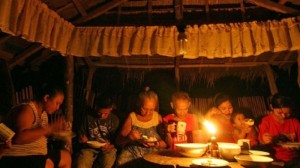Estimated brownout losses in Mindanao: P30M/hour
DAVAO CITY, Philippines—Businesses in Mindanao are estimated to be losing P30 million per hour as a result of the shortage of electricity that has led to daily outages of up to six hours, according to a top official of a business group in Cagayan de Oro City.
Efren Uy, head of the Cagayan de Oro Chamber of Commerce and Industry (CDOCCI), said that for every 300 to 350 megawatts of power deficiency, “we lose P30 million per hour.”
In Cagayan de Oro alone, the demand for electricity is
140 MW but supply is just 39 MW, according to Marilyn Echavez, community relations manager of the Cagayan de Oro Electric Light and Power Co (Cepalco), the main power distributor in the city.
According to Uy, the estimated losses that businesses in Mindanao suffer every hour include expenses that stores, offices and factories are forced to incur on generators.
The national government has offered few solutions, among them an executive order issued by President Aquino that sets aside more than P4 billion in funds for loans to electric cooperatives in Mindanao to be used to buy so-called modular generator sets.
The use of the modular generators, however, would increase power rates, which Mr. Aquino had said Mindanao consumers have to bear.
The shortage of electricity was worsened by the reduced output of Mindanao’s hydropower facilities—the Agus and Pulangi plants.
The two facilities account for 60 percent of Mindanao’s power needs.
In Pulangi alone, the lack of water has reduced the output of the hydro facility to just 60 MW, according to Rudy Brioso, vice president for Mindanao generation of the National Power Corp. (Napocor).
Brioso said the same thing is happening at the Agus power plants in Lanao, which draw water from Lake Lanao.
He said while the current water elevation in Lake Lanao is still more than the critical level of 698.2 meters, the absence of rain is threatening to drag it down past its critical level.
He said if water level at the lake drops further, “we will be forced to shut down the plants,” which would worsen Mindanao’s power crisis.
The dry spell is also threatening Mindanao’s food supply, according to officials.
According to Armando Ansingco, chair of the Southern Mindanao regional agriculture and fishery council (RAFC), crop yield in Mindanao is expected to fall by 20 percent as a result of the dry spell.
Farms in well-irrigated areas may not immediately feel the dry spell’s effects, but rain-fed farms are suffering now, said Ansingco.
According to Remelyn Recoter, Department of Agriculture director in Southern Mindanao, 80 percent of farms in Southern Mindanao are irrigated.
Ansingco said farmers need to plant drought-resistant crops as soon as they can. “Let us brace for the worst and prepare ourselves,” said Ansingco. “We can do it because we’ve been here before,” he said.
Recoter said cloud-seeding operations are being studied.
The dry spell’s effects are now being felt in Magsaysay, a farming town in Davao del Sur where the planting season has been delayed because of low water level in irrigation systems.
Exequiel Elentorio, head of the Badagoy Irrigators Association in Magsaysay, said farmers are now resorting to water rationing.
The same is true in Maguindanao. Farmer Kali Usman, of Upi town, said planting has stopped in rain-fed farms in the province. Bobby Lagsa, Germelina Lacorte, Orlando Dinoy and Richel Umel, Inquirer Mindanao
